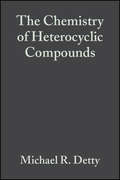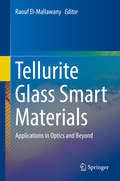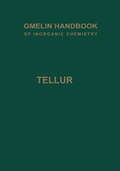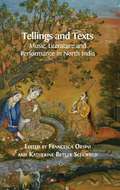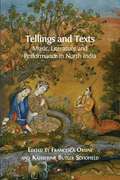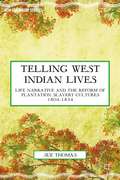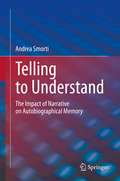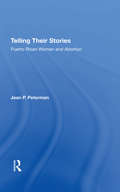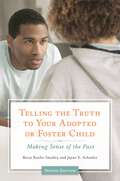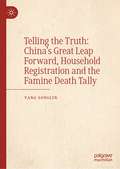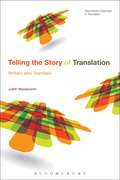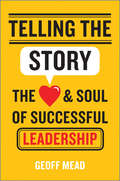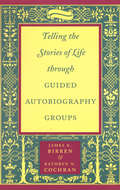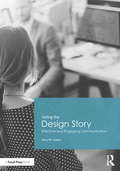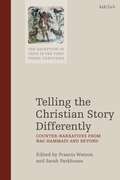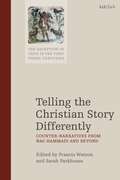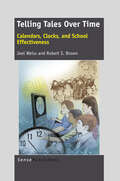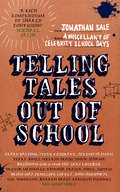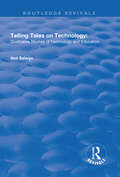- Table View
- List View
Tellurium-Containing Heterocycles (Chemistry of Heterocyclic Compounds: A Series Of Monographs #178)
by Michael R. Detty Marie B. O'ReganThe Chemistry of Heterocyclic Compounds, since its inception, has been recognized as a cornerstone of heterocyclic chemistry. Each volume attempts to discuss all aspects – properties, synthesis, reactions, physiological and industrial significance – of a specific ring system. To keep the series up-to-date, supplementary volumes covering the recent literature on each individual ring system have been published. Many ring systems (such as pyridines and oxazoles) are treated in distinct books, each consisting of separate volumes or parts dealing with different individual topics. With all authors are recognized authorities, the Chemistry of Heterocyclic Chemistry is considered worldwide as the indispensable resource for organic, bioorganic, and medicinal chemists.
Tellurite Glass Smart Materials: Applications in Optics and Beyond
by Raouf El-MallawanyThis book provides expert coverage of the physical properties of new non-crystalline solids—tellurite glass smart materials—and the latest applications of these materials, offering insights into innovative applications for radiation shielding, energy harvesting, laser devices, and temperature sensing, among others. In particular, there is a focus on optics, energy conversion technology and laser devices, structural and luminescence properties for laser applications, optothermal and optical properties in the presence of gold nanoparticles, and lanthanide doped zinc oxyfluoro-tellurite glass as a new smart material.Additional chapters address the properties and uses of tellurite glasses in optical sensing, the significance of Near Infrared (NIR) emissions, solar cells, solar energy harvesting, luminescent displays, and the development of bioactive-based tellurite-lanthanide (Te-Ln) doped hydroxyapatite composites for biomedical applications.As the world’s reliance on glass increases, this book serves as a link between the latest findings on tellurite glasses and real-world technological advancement. Academic researchers and industry professionals alike will find this book a useful resource in keeping abreast of recent developments in the field.
Tellur (Gmelin Handbook of Inorganic and Organometallic Chemistry - 8th edition #T-e / 0)
by Erich PietschTellings and Texts: Music, Literature And Performance In North India
by Francesca Orsini Katherine Butler SchofieldExamining materials from early modern and contemporary North India and Pakistan, Tellings and Texts brings together seventeen first-rate papers on the relations between written and oral texts, their performance, and the musical traditions these performances have entailed. The contributions from some of the best scholars in the field cover a wide range of literary genres and social and cultural contexts across the region. The texts and practices are contextualized in relation to the broader social and political background in which they emerged, showing how religious affiliations, caste dynamics and political concerns played a role in shaping social identities as well as aesthetic sensibilities. By doing so this book sheds light into theoretical issues of more general significance, such as textual versus oral norms; the features of oral performance and improvisation; the role of the text in performance; the aesthetics and social dimension of performance; the significance of space in performance history and important considerations on repertoires of story-telling. The book also contains links to audio files of some of the works discussed in the text. Tellings and Texts is essential reading for anyone with an interest in South Asian culture and, more generally, in the theory and practice of oral literature, performance and story-telling.
Tellings and Texts: Music, Literature and Performance in North India (PDF)
by Francesca Orsini Katherine Butler SchofieldExamining materials from early modern and contemporary North India and Pakistan, Tellings and Texts brings together seventeen first-rate papers on the relations between written and oral texts, their performance, and the musical traditions these performances have entailed. The contributions from some of the best scholars in the field cover a wide range of literary genres and social and cultural contexts across the region. The texts and practices are contextualized in relation to the broader social and political background in which they emerged, showing how religious affiliations, caste dynamics and political concerns played a role in shaping social identities as well as aesthetic sensibilities. By doing so this book sheds light into theoretical issues of more general significance, such as textual versus oral norms; the features of oral performance and improvisation; the role of the text in performance; the aesthetics and social dimension of performance; the significance of space in performance history and important considerations on repertoires of story-telling. Tellings and Texts is essential reading for anyone with an interest in South Asian culture and, more generally, in the theory and practice of oral literature, performance and story-telling.
Telling West Indian Lives: Life Narrative and the Reform of Plantation Slavery Cultures 1804–1834 (New Caribbean Studies)
by S. ThomasTelling West Indian Lives: Life Narrative and the Reform of Plantation Slavery Cultures 1804-1834 draws historical and literary attention to life story and narration in the late plantation slavery period. Drawing on new archival research, it highlights the ways written narrative shaped evangelical, philanthropic, and antislavery reform projects.
Telling to Understand: The Impact of Narrative on Autobiographical Memory
by Andrea SmortiThis book illustrates the link that unites memory, thought, and narration, and explores how the act of telling helps people to understand themselves and others. The structure of the book is divided into two parts. The first part focuses on the aspect of narrative comprehension—the person as narrator. It identifies two different origins of narrative comprehension (memory and play) and argues that the narratives we produce starting from autobiographical memory are intended to give order and meaning to events that happened in the past, in order to be able to interpret the present. Conversely, the narratives we produce starting from play are aesthetically constructed, not forced to respect reality, and because of this create potential new worlds of understanding. The second part of this book is devoted to the study of narrative understanding as an understanding of the other. Chapters examine the different points of view a listener can adopt in order to interpret the text produced by a narrator and how these points of view can interact with each other. The book concludes with a consideration of narrative comprehension in the digital world, and examines the principal effects of stories and narrative on the notion of self in the realm of the “Internet galaxy.” Telling to Understand will be of interest to researchers and students in cognitive science, psychology, literary studies, philosophy, education, and educational technology, as well as any reader interested in enlarging their concept of narrative and how narrating modifies the self.
Telling Their Stories: Puerto Rican Women And Abortion
by Jean PetermanAbortion and the right of a woman to control her fertility cross boundaries of race, ethnicity, and social class. In this revealing and in-depth study, Jean P. Peterman focuses on a group of Puerto Rican women in Chicago whose decisions about abortion highlight the contradictions between the sexually conservative ethnic and religious beliefs of this community and the fact that Latina women (including Puerto Rican women) have abortions at a rate one and a half times as high as non-Latinas. For more than half the women Peterman interviewed, their decision to have an abortion allowed them to maintain opportunities for themselves or to resist male control. Despite their resistance to traditional gender roles, their Puerto Rican identity remains strong. The term “cultural story,†coined by sociologist Laurel Richardson, explains how cultures create and support their social worlds—their cultural and social frameworks as well as beliefs about home, community, sex roles, and family. A “collective story†is an oppositional story—a form of resistance and a catalyst for change. In this book, the stories recounted by these women involve struggles against barriers instrinsic to their social structure, such as poverty, prejudice, and discrimination, that ultimately shape newfound feelings of independence, inner strength, and control over their own fertility and their lives.
Telling Their Stories: Puerto Rican Women And Abortion
by Jean PetermanAbortion and the right of a woman to control her fertility cross boundaries of race, ethnicity, and social class. In this revealing and in-depth study, Jean P. Peterman focuses on a group of Puerto Rican women in Chicago whose decisions about abortion highlight the contradictions between the sexually conservative ethnic and religious beliefs of this community and the fact that Latina women (including Puerto Rican women) have abortions at a rate one and a half times as high as non-Latinas. For more than half the women Peterman interviewed, their decision to have an abortion allowed them to maintain opportunities for themselves or to resist male control. Despite their resistance to traditional gender roles, their Puerto Rican identity remains strong. The term “cultural story,†coined by sociologist Laurel Richardson, explains how cultures create and support their social worlds—their cultural and social frameworks as well as beliefs about home, community, sex roles, and family. A “collective story†is an oppositional story—a form of resistance and a catalyst for change. In this book, the stories recounted by these women involve struggles against barriers instrinsic to their social structure, such as poverty, prejudice, and discrimination, that ultimately shape newfound feelings of independence, inner strength, and control over their own fertility and their lives.
Telling the Truth to Your Adopted or Foster Child: Making Sense of the Past
by Betsy Keefer Smalley Jayne E. SchoolerMany adopted or foster children have complex, troubling, often painful pasts. This book provides parents and professionals with sound advice on how to communicate effectively about difficult and sensitive topics, providing concrete strategies for helping adopted and foster children make sense of the past so they can enjoy a healthy, well-adjusted future.Approximately one of every four adopted children will have adjustment challenges related to their separation from the birth family, earlier trauma, attachment difficulties, and/or issues stemming from the adoption process. Common complicating issues of adopted children are feelings of rejection, abandonment, or confusion about their origins. While many foster and adoptive parents and even many professionals are reluctant to communicate openly about birth histories, silence only adds to the child's confusion and pain.This revised and significantly expanded edition of the award-winning Telling the Truth to Your Adopted or Foster Child equips parents with the knowledge and tools they need to communicate with their adopted or foster child about their past. Revisions include coverage of significant new research and information regarding the importance of understanding the child's trauma history to his or her well-being and successful adjustment in his foster or adoptive family. The authors answer such questions as: How do I share difficult information about my child's adoption in a sensitive manner? When is the right time to tell my child the whole truth? How do I obtain more information on my child's history? Detailed descriptions of actual cases help the parent or caregiver find ways to discover the truth (particularly in closed and international adoption cases), organize the information, and explain the details of the past gently to a toddler, child, or young adult who may find it frightening or confusing.
Telling the Truth to Your Adopted or Foster Child: Making Sense of the Past
by Betsy Keefer Smalley Jayne E. SchoolerMany adopted or foster children have complex, troubling, often painful pasts. This book provides parents and professionals with sound advice on how to communicate effectively about difficult and sensitive topics, providing concrete strategies for helping adopted and foster children make sense of the past so they can enjoy a healthy, well-adjusted future.Approximately one of every four adopted children will have adjustment challenges related to their separation from the birth family, earlier trauma, attachment difficulties, and/or issues stemming from the adoption process. Common complicating issues of adopted children are feelings of rejection, abandonment, or confusion about their origins. While many foster and adoptive parents and even many professionals are reluctant to communicate openly about birth histories, silence only adds to the child's confusion and pain.This revised and significantly expanded edition of the award-winning Telling the Truth to Your Adopted or Foster Child equips parents with the knowledge and tools they need to communicate with their adopted or foster child about their past. Revisions include coverage of significant new research and information regarding the importance of understanding the child's trauma history to his or her well-being and successful adjustment in his foster or adoptive family. The authors answer such questions as: How do I share difficult information about my child's adoption in a sensitive manner? When is the right time to tell my child the whole truth? How do I obtain more information on my child's history? Detailed descriptions of actual cases help the parent or caregiver find ways to discover the truth (particularly in closed and international adoption cases), organize the information, and explain the details of the past gently to a toddler, child, or young adult who may find it frightening or confusing.
Telling the Truth: China’s Great Leap Forward, Household Registration and the Famine Death Tally
by Songlin YangThis book discusses what is often called the “Great Leap Famine”, which occurred in China during the years from 1959 to 1961. Scholarly consensus suggests that 30 million Chinese perished. Yang Songlin’s book provides an evidence-based, systematic and substantial rebuff, concluding that a much smaller number of deaths can be verified. This book is of interest to scholars of China and Chinese development and politics, economists, and demographers.
Telling the Time Activity Book for Ages 5-7
by Cgp BooksA fun, colourful Activity Book packed with charming characters and engaging activities. It's ideal for introducing your child to telling the time, and learning about the days, weeks and months of the year! We've explained everything in easy-to-understand language with loads of colourful diagrams - your child will be time-wiz before you know it! Each topic is covered by a range of activities - all designed to help that time-telling knowledge really stick. We’ve also thrown in a selection of exciting puzzles so your child can apply their Maths skills in a different context. Answers can be found at the back of the book.
Telling the Story of Translation: Writers who Translate (Bloomsbury Advances in Translation)
by Judith WoodsworthScholars have long highlighted the links between translating and (re)writing, increasingly blurring the line between translations and so-called 'original' works. Less emphasis has been placed on the work of writers who translate, and the ways in which they conceptualize, or even fictionalize, the task of translation. This book fills that gap and thus will be of interest to scholars in linguistics, translation studies and literary studies. Scrutinizing translation through a new lens, Judith Woodsworth reveals the sometimes problematic relations between author and translator, along with the evolution of the translator's voice and visibility. The book investigates the uses (and abuses) of translation at the hands of George Bernard Shaw, Gertrude Stein and Paul Auster, prominent writers who bring into play assorted fictions as they tell their stories of translations. Each case is interesting in itself because of the new material analysed and the conclusions reached. Translation is seen not only as an exercise and fruitful starting point, it is also a way of paying tribute, repaying a debt and cementing a friendship. Taken together, the case studies point the way to a teleology of translation and raise the question: what is translation for? Shaw, Stein and Auster adopt an authorial posture that distinguishes them from other translators. They stretch the boundaries of the translation proper, their words spilling over into the liminal space of the text; in some cases they hijack the act of translation to serve their own ends. Through their tales of loss, counterfeit and hard labour, they cast an occasionally bleak glance at what it means to be a translator. Yet they also pay homage to translation and provide fresh insights that continue to manifest themselves in current works of literature. By engaging with translation as a literary act in its own right, these eminent writers confer greater prestige on what has traditionally been viewed as a subservient art.
Telling the Story of Translation: Writers who Translate (Bloomsbury Advances in Translation)
by Judith WoodsworthScholars have long highlighted the links between translating and (re)writing, increasingly blurring the line between translations and so-called 'original' works. Less emphasis has been placed on the work of writers who translate, and the ways in which they conceptualize, or even fictionalize, the task of translation. This book fills that gap and thus will be of interest to scholars in linguistics, translation studies and literary studies. Scrutinizing translation through a new lens, Judith Woodsworth reveals the sometimes problematic relations between author and translator, along with the evolution of the translator's voice and visibility. The book investigates the uses (and abuses) of translation at the hands of George Bernard Shaw, Gertrude Stein and Paul Auster, prominent writers who bring into play assorted fictions as they tell their stories of translations. Each case is interesting in itself because of the new material analysed and the conclusions reached. Translation is seen not only as an exercise and fruitful starting point, it is also a way of paying tribute, repaying a debt and cementing a friendship. Taken together, the case studies point the way to a teleology of translation and raise the question: what is translation for? Shaw, Stein and Auster adopt an authorial posture that distinguishes them from other translators. They stretch the boundaries of the translation proper, their words spilling over into the liminal space of the text; in some cases they hijack the act of translation to serve their own ends. Through their tales of loss, counterfeit and hard labour, they cast an occasionally bleak glance at what it means to be a translator. Yet they also pay homage to translation and provide fresh insights that continue to manifest themselves in current works of literature. By engaging with translation as a literary act in its own right, these eminent writers confer greater prestige on what has traditionally been viewed as a subservient art.
Telling the Story: The Heart and Soul of Successful Leadership
by Geoff MeadHow to master the art of narrative leadership Telling the Story shows how leaders affect our understanding of what is possible and desirable through the stories they tell. It opens a door into the world of narrative leadership: what stories are and how they work; when to tell a story and how to tell one well; and how the language and metaphors we use influence our actions and change how we think about the world. • Explains how narrative leadership shapes and defines what’s possible on an organizational level • Written by a renowned consultant on the art of narrative leadership • Challenges leaders to consider how narrative can influence and help create the kind of society they envision
Telling the Story: The Heart and Soul of Successful Leadership
by Geoff MeadHow to master the art of narrative leadership Telling the Story shows how leaders affect our understanding of what is possible and desirable through the stories they tell. It opens a door into the world of narrative leadership: what stories are and how they work; when to tell a story and how to tell one well; and how the language and metaphors we use influence our actions and change how we think about the world. • Explains how narrative leadership shapes and defines what’s possible on an organizational level • Written by a renowned consultant on the art of narrative leadership • Challenges leaders to consider how narrative can influence and help create the kind of society they envision
Telling the Stories of Life through Guided Autobiography Groups
by James E. Birren Kathryn N. CochranTelling the Stories of Life through Guided Autobiography Groups, based on James Birren's 25 years of conducting autobiography groups, discusses all the topics an organizer faces while developing a program for adults who want to recall and write down their life histories. This book is ideal for adult education programs, church groups, social workers, psychologists, gerontologists, and others who work with adults who might be interested in exploring, recording, or sharing their personal histories. It helps professionals and trained workshop leaders at community centers, senior centers, schools and other settings guide group participants in exploring major themes of their lives so that they can organize and write their stories and share them in a group with others on the same journey. This exercise is rewarding for adults of any age in a period of transition or with interest in gaining insight from their own stories. Personal development and a feeling of connection to other participants and their stories is a natural outcome of this process. This book provides background material and detailed lesson plans for those who wish to develop and lead an autobiography group.The authors explain the concept of guided autobiography, discuss the benefits to the group participants, and provide logistical information on how to plan, organize, and set up a group. An appendix provides exercises, handouts, and suggested adaptations for specific groups. The book also explains a systematic method of priming memories, including the history of family and of one's life work, the role of money, health and the body, and ideas about death.At a time when rapid change has created a widespread yearning to write down and exchange personal accounts, sharing life stories can reveal a great deal about how we have come to be the persons we are. Telling the Stories of Life through Guided Autobiography Groups shows how to organize, record, and share life experiences through a proven and effective technique.
Telling the Design Story: Effective and Engaging Communication
by Amy HuberWhen presenting projects in competitive design environments, how you say something is as important as what you’re actually saying. Projects are increasingly complex and designers are working from more sources, and many designers are familiar with the struggle to harness this information and craft a meaningful and engaging story from it. Telling the Design Story: Effective and Engaging Communication teaches designers to craft cohesive and innovative presentations through storytelling. From the various stages of the creative process to the nuts and bolts of writing for impact, speaking skills, and creating visuals, Amy Huber provides a comprehensive approach for designers creating presentations for clients. Including chapter by chapter exercises, project briefs, and forms, this is an essential resource for students and practicing designers alike.
Telling the Design Story: Effective and Engaging Communication
by Amy HuberWhen presenting projects in competitive design environments, how you say something is as important as what you’re actually saying. Projects are increasingly complex and designers are working from more sources, and many designers are familiar with the struggle to harness this information and craft a meaningful and engaging story from it. Telling the Design Story: Effective and Engaging Communication teaches designers to craft cohesive and innovative presentations through storytelling. From the various stages of the creative process to the nuts and bolts of writing for impact, speaking skills, and creating visuals, Amy Huber provides a comprehensive approach for designers creating presentations for clients. Including chapter by chapter exercises, project briefs, and forms, this is an essential resource for students and practicing designers alike.
Telling the Christian Story Differently: Counter-Narratives from Nag Hammadi and Beyond (The Reception of Jesus in the First Three Centuries)
by Francis Watson Sarah ParkhouseThis volume examines the 'counter-narratives' of the core Christian story, proposed by texts from Nag Hammadi and elsewhere. A noteworthy body of highly respected scholars examine material that is sometimes difficult and often overlooked, contributing to the ongoing effort to integrate Nag Hammadi and related literature into the mainstream of New Testament and early Christian studies. By retracing the major elements of the Christian story in sequence, they are able to discuss how and why each aspect was disputed on inner-Christian grounds, and to reflect on the different accounts of Christian identity underlying these disputes. Together the essays in this book address a central issue: towards the end of the second century, Irenaeus could claim that the overwhelming majority of Christians throughout the world were agreed on a version of the core Christian story which is still recognisable today. Yet, as Irenaeus concedes and as the Nag Hammadi texts have confirmed, there were many who wished to tell the core Christian story differently. Those who criticized and rejected the standard story did so not because they were adherents of another religion, 'Gnosticism', but because they were Christians who believed that the standard account was wrong at point after point. Ranging from the Gospels of Judas and Mary to Galatians and Ptolemy's Letter to Flora, this volume provides a fascinating analysis of how the Christian story as we know it today developed against counter-readings from other early Christian traditions.
Telling the Christian Story Differently: Counter-Narratives from Nag Hammadi and Beyond (The Reception of Jesus in the First Three Centuries)
by Francis Watson Sarah ParkhouseThis volume examines the 'counter-narratives' of the core Christian story, proposed by texts from Nag Hammadi and elsewhere. A noteworthy body of highly respected scholars examine material that is sometimes difficult and often overlooked, contributing to the ongoing effort to integrate Nag Hammadi and related literature into the mainstream of New Testament and early Christian studies. By retracing the major elements of the Christian story in sequence, they are able to discuss how and why each aspect was disputed on inner-Christian grounds, and to reflect on the different accounts of Christian identity underlying these disputes. Together the essays in this book address a central issue: towards the end of the second century, Irenaeus could claim that the overwhelming majority of Christians throughout the world were agreed on a version of the core Christian story which is still recognisable today. Yet, as Irenaeus concedes and as the Nag Hammadi texts have confirmed, there were many who wished to tell the core Christian story differently. Those who criticized and rejected the standard story did so not because they were adherents of another religion, 'Gnosticism', but because they were Christians who believed that the standard account was wrong at point after point. Ranging from the Gospels of Judas and Mary to Galatians and Ptolemy's Letter to Flora, this volume provides a fascinating analysis of how the Christian story as we know it today developed against counter-readings from other early Christian traditions.
Telling Tales Over Time: Calendars, Clocks, and School Effectiveness
by Joel Weiss Robert S. BrownHow do calendars and clocks influence considerations of school effectiveness? From the creation of compulsory education to the future of virtual schooling, Weiss and Brown trace two centuries of school practices, policies and research linking the concept of time with ‘opportunity to learn’. School calendars and clocks are shaped by both the physical and social worlds, and the ‘clock of schooling’ is shown to be one of the ‘great clocks of society’ that helps to frame school effectiveness. School time does not operate in a vacuum, but within curriculum, teaching and learning situations. The phrase ‘chrono-curriculum’ was devised by the authors as a metaphor for exploring issues of school effectiveness within the time dimension. Using American and Canadian sources, stories are created to illustrate four themes about time and school effectiveness. The first three stories utilize access, attendance and testing as criteria associated with these eras of schooling. How will the story read in the fourth era, the digital age, which forces us to a reconsideration of time and its influence on education? Quoting David Berliner in his Foreword: “ this is an opportune time for these authors to bring us insights into the reasons we in North America created our public school systems, and how the chrono-curriculum influences those systems. The authors’ presentation of our educational past provides educators a chance to think anew about how we might do schooling in our own times.”
Telling Tales Out of School: A Miscellany of Celebrity School Days
by Jonathan SaleWHICH UNIVERSITY CHALLENGE PRESENTER FAILED HIS ELEMENTARY MATHS O LEVEL SIX TIMES? FOR WHICH DRAGONS' DEN INVESTOR WAS FLOGGING LEATHER JACKETS A LUNCH BREAK ACTIVITY? WHICH ENVIRONMENTALIST WAS EXPELLED AT PRIMARY SCHOOL FOR ATTEMPTING TO POISON HIS CLASSMATES WITH DEADLY NIGHTSHADE? WHICH ADVENTURER AND EXPLORER SPENT HIS TIME AT ETON SHINNING UP THE ARCHITECTURE? Through intimate conversations with journalist Jonathan Sale, some of Britain's leading personalities reminisce about their school and college days, revealing the portents, paths and false starts that led them to where they are today. With poignant and hilarious anecdotes spanning everything from those very first days at school to receiving their dreaded O level, A level and degree results, this book is brimming with recollections that every reader can associate with. Tributes are paid to the teachers who opened doors, whilst others tell tales on those who slammed them in their faces. And all credit to the teachers who were truly prophetic about their pupils. These personalities may be reticent with regard to their adult personal lives, but speak candidly about their childhoods, revealing fascinating insights into the role their formative years played in shaping them to become the people they are today.
Telling Tales on Technology: Qualitative Studies of Technology and Education
by Neil SelwynThis title was first published in 2002.The educational potential of information and communications technology (ICT) has been speculated upon endlessly - from the early days of the micro-computer to the present excitement surrounding virtual education and e-learning . Now, with current multi-billion dollar initiatives such as the UK National Grid for Learning and US Technology Literacy Challenge, ICT is an unavoidable element of education. Yet despite a plethora of promises and policies, new technologies have failed to be wholly integrated into education. Telling Tales on Technology critically examines the role of ICT in education and explores how, given its assumed importance, new technology remains a peripheral part of much of what goes on in education. Based on in-depth qualitative studies, the book takes a comprehensive yet questioning look over the past two decades of educational technology policy and practice and positions it within the wider social, cultural, political and economic notion of the information age . Drawing on interviews with students, teachers, politicians and business people as well as comprehensive documentary analysis, this is an essential text for anyone thinking seriously about the use of ICT in education.
